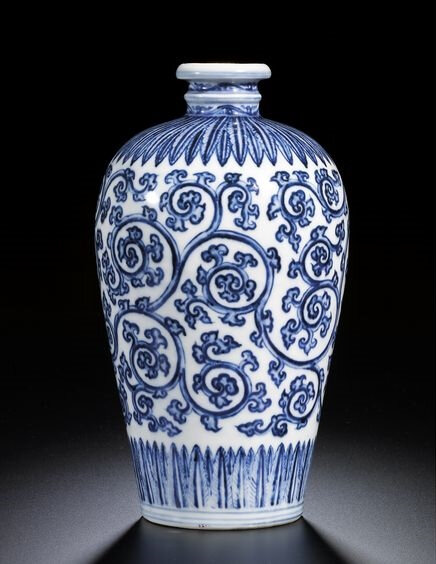A fine and extremely rare blue and white 'foliate scroll' meiping, Ming dynasty, Chenghua period (1464-1487)
Lot 2622. A fine and extremely rare blue and white 'foliate scroll' meiping, Ming dynasty, Chenghua period (1464-1487). 26.5 cm., 10 1/2 in. Estimate 20,000,000 — 30,000,000 HKD. Lot sold 43,220,000 HKD. Courtesy Sotheby's 2010.
the round-shouldered elegantly tapering body rising from a recessed base to a narrow short ribbed neck with everted rolled rim, finely painted in rich heaped and piled cobalt-blue tones around the exterior with a broad undulating foliate scroll band, all between a stiff pendant plantain-leaf band draping the shoulders repeated as upright leaves skirting the foot, the neck with two simple scroll bands divided by a single line at the rib, the base unglazed.
Provenance: Collection of Robert C. Bruce (one of a pair, acquired in London prior to 1950).
Sotheby's London, 12th May 1953, lot 87 (sold together with its pair).
Collection of H.R.N. Norton.
Sotheby's London, 5th November 1963, lot 160.
Collection of J. T. Tai.
Hugh M. Moss Ltd. (1970s, reunited with its pair).
Exhibited: Ming Blue-and-White Porcelain, Oriental Ceramic Society, London, 1946, cat. no. 97 (together with its pair).
Literature: Adrian M. Joseph, Ming Porcelains. Their Origins and Development, London, 1971, pl. 39 (shown left, together with its pair).
An Extremely Rare Chenghua Meiping
Regina Krahl
Only two other meiping of this form and design appear to be recorded. The pair to this vase, also from the collection of Robert C. Bruce, was sold in our London rooms in 1953 together with the present piece. The two vases were subsequently separated, but reunited again in the 1970s at Hugh M. Moss Ltd, when both were illustrated together in Adrian Joseph, op.cit. pl. 39. Thereafter they were separated once more. The pair to our vase was then sold in our London rooms 1st/2nd April 1974, lot 197, entered the collection of the British Rail Pension Fund, was exhibited on loan at the Dallas Museum of Art from 1985 to 1988, and sold again in these rooms 16th May 1989, lot 18.
The only other example of this design is a fragmentary piece excavated from the tomb of the only son of Wan Guifei (1430-1487), favourite consort of the Chenghua emperor, who died less than a year old in the second year of the Chenghua reign (1466). The tomb was discovered in Xiangshanlu in the Haiding district in the northwest of Beijing, in a resting place reserved for imperial princes, consorts and eunuchs. Since the death of the boy was obviously unexpected, the vase was most likely made immediately after his demise and must represent one of the earliest imperial commissions of the Chenghua period. The excavation is discussed in Wang Yanling, 'Haiding Xiangshan Jun Keyuan Ming Taizi mu fajue jianbao [Short report on the excavation of a Ming Crown Prince's tomb at the Xiangshan Military Academy at Haiding], Beijing Wenwu yu Kaogu, no. 5, Beijing, 2002, pp. 68-70, where the meiping is illustrated as fig. 3. The piece is further discussed in Han Hongye and Wang Yanling, 'Beijing Jun Keyuan sushelou chutu qinghua meiping de niandai chutan [First enquiry into the dating of a blue-and-white meiping excavated at the dormitory of the Military Academy in Beijing], Beijing Wenwu yu Kaogu, no. 6, Beijing, 2004, pp. 269-73, where the British Rail example is illustrated for comparison, fig. 2: 5, with a detail fig. 3: 1.
Blue-and-white meiping vases appear traditionally to have been accompanying imperial or royal burials. According to Kong Fanzhi, 'Shitan Ming mu suizang meiping de shiyong zhidu [A bid to discuss regulations concerning the use of meipingburied in Ming tombs], Wenwu 1985, no. 12, pp. 90-92, four blue-and-white meiping, apparently the largest number of meiping found in any tomb, were reserved for emperors' mausolea, such as Dingling, the tomb of the Wanli emperor; two blue-and-white vases, or one blue-and-white and one white, were given to empress dowagers, empresses and important consorts, and single blue-and-white meiping accompanied princes and princesses into the afterlife. Even if this stipulation may not always have been rigorously followed and the frequent robbery of tombs may thwart a clear analysis, it nevertheless strongly suggests that the present vase derives from an important imperial context.
Both in shape and design, these vases are closely related to Xuande prototypes, as is typical of early Chenghua porcelain. The shape, which represents a variation on the classic meiping form, with its emphasized neck with prominent rim flange and raised rib halfway up, is extremely rare. A similar treatment of the neck can be seen on earlier pilgrim flasks, and related meiping, without the raised rib on the neck and decorated with formal lotus scrolls between similar leaf borders, are known of Xuande mark and period; a vase of this type was included in the exhibition The Exquisite Chinese Artifacts. Collection of Ching Wan Society, National Museum of History, Taipei, 1995, cat. no. 95 . The scrollwork is also vaguely related to Xuande prototypes and appears somewhat similarly, for example, on blue-and-white jars, see Mingdai Xuande guanyao jinghua tezhan tulu/Catalogue of the Special Exhibition of Selected Hsüan-te Imperial Porcelains of the Ming Dynasty, National Palace Museum, Taipei, 1998, cat. no. 35. The design of pendant leaves at the shoulder and upright ones above the foot, however, is more often seen on Chenghua porcelain, for example on a meiping vase of different type and two guan jars illustrated in Geng Baochang, Ming Qing ciqi jianding [Appraisal of Ming and Qing porcelain], Hong Kong, 1993, figs. 150, 152 and 153.
Sotheby's. Fine Chinese Ceramics & Works of Art, Hong Kong, 08 Oct 2010

/https%3A%2F%2Fprofilepics.canalblog.com%2Fprofilepics%2F1%2F0%2F100183.jpg)
/https%3A%2F%2Fstorage.canalblog.com%2F03%2F02%2F119589%2F96711876_o.jpg)
/https%3A%2F%2Fstorage.canalblog.com%2F11%2F31%2F119589%2F94773502_o.jpg)
/https%3A%2F%2Fstorage.canalblog.com%2F20%2F83%2F119589%2F94772815_o.jpg)
/https%3A%2F%2Fstorage.canalblog.com%2F26%2F72%2F119589%2F75604929_o.jpg)
/https%3A%2F%2Fstorage.canalblog.com%2F59%2F60%2F119589%2F26458628_o.jpg)






/image%2F1371349%2F20240416%2Fob_2a8420_437713933-1652609748842371-16764302136.jpg)
/image%2F1371349%2F20240414%2Fob_83ee65_2024-nyr-22642-0954-000-a-blue-and-whi.jpg)
/image%2F1371349%2F20240414%2Fob_15808c_2024-nyr-22642-0953-000-a-blue-and-whi.jpg)
/image%2F1371349%2F20240414%2Fob_e54295_2024-nyr-22642-0952-000-a-rare-blue-an.jpg)